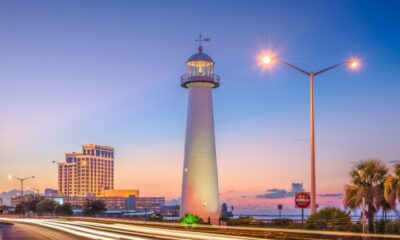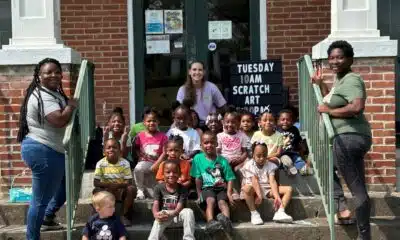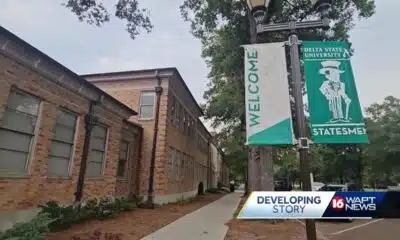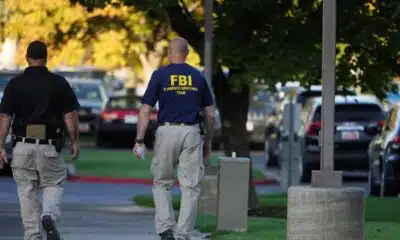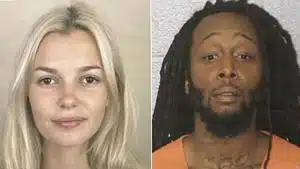Mississippi Today
The story of Dr. Martin Luther King Jr.’s 1966 visit to Sunflower County

Editor’s note: This article was written by Bryan Davis, publisher of The Enterprise-Tocsin newspaper in Indianola. It first published on June 21 and is republished below with permission. Click here to read the story on The Enterpise-Tocsin’s website.
It all happened on a dirt pile, on a construction site.
That was not the typical pulpit for Dr. Martin Luther King Jr., but on June 21, 1966, on the grounds of the Sunflower County Courthouse, that would have to do.
King arrived in Indianola that afternoon with little fanfare. There was no stage or speaker system set up outside of the courthouse.
The crowd was thin by the standards of most of King’s speeches. That didn’t matter. The famed Civil Rights leader and Nobel Peace Prize winner was going to say what he came to say.
About 450 people, mostly local Black citizens, gathered to hear him speak. And what a speech it was.
King’s stop in Indianola probably would never have happened had it not been for James Meredith being shot on the second day of his famed March Against Fear earlier that month. That prompted King and other Civil Rights leaders to come to the state to finish the march.
His speech in Indianola has long been relegated to the footnotes of history, but the words spoken on the courthouse grounds that day may have revealed one of King’s more vulnerable moments.
Indianola resident and former Student Nonviolent Coordinating Committee Field Secretary Charles McLaurin told The Enterprise-Tocsin that the march was originally intended to route straight down Highway 51 from Memphis to Jackson, but voting rights hero and Ruleville native Fannie Lou Hamer asked McLaurin to travel to Grenada to ask King and SNCC leader Stokely Carmichael to divert into the Delta.
“She said, ‘We got fear here too,’” McLaurin recounted.
King was fighting wars on multiple fronts during the summer of 1966. His primary focus was no longer on the segregationist South. He was spending a lot of time in larger northern cities like Chicago, fighting for equal and affordable housing rights.
After Meredith was shot, he agreed to join the march, and he was often back-and-forth that summer between places like Chicago, Atlanta and Mississippi.
In his own circle, there was intense infighting about the “Black Power” slogan that was becoming more popular during SNCC rallies.
King vehemently opposed the Black Power movement, so much so that he returned to Mississippi on multiple occasions that summer in order to squash momentum from that side and to promote nonviolence.
By the morning of June 21, 1966, King was back in Mississippi.
That day, the March Against Fear splintered off into two groups. The main cluster of marchers pushed on from the hot, dusty Delta town of Louise toward Yazoo City.
A smaller contingency, led by King, flew to Meridian, with hopes of arriving later that day in Philadelphia to help locals there pay tribute to Andrew Goodman, Michael Schwerner and James Chaney, three Civil Rights workers who had been murdered exactly two years before in Neshoba County.
King would attend three rallies that day. One of those was in Philadelphia. The second was in Indianola. The third was in Yazoo City.
Local white leaders in Indianola and Yazoo City, many involved in the White Citizens Council, warned away counter protesters in an effort to keep the peace.
White leadership in Philadelphia and Neshoba County did not seem quite as worried about negative publicity, and many seemed to revel in the violence that followed.
The events that unfolded in Philadelphia had an immediate impact on King, and when he arrived in Indianola to speak later that day, he was fired up.
“Hatred is running very deep there,” King said of Philadelphia, according to an article in the Delta Democrat-Times the next day. “Something is going to have to be done about it.”
King vented in Indianola, and he left out no one, including state, local and federal policing agencies, as well as Sunflower County’s own Senator James O. Eastland.
“We have to get rid of Eastland if the Civil Rights movement is to go forward,” the Clarion Ledger reported King as saying at the Sunflower County Courthouse.
On June 22, 1966, accounts of King’s speech in Indianola flooded most of the nation’s newspapers. Many of those accounts were on the front pages of those papers.
By nightfall on June 21, King was in Yazoo City, his attention diverted somewhat from Philadelphia back to the Black Power movement. His tone was much more collected than it had been in Indianola.
King and the marchers left Yazoo City and traveled down Highway 16 toward Canton. A historical marker on the grounds of the American Methodist Episcopal Church in Benton commemorates King’s brief stop there along the way.
There is no such marker at the courthouse in Sunflower County.
On June 23, 1966, in Canton, marchers made national headlines again when they were teargassed by law enforcement when they tried to pitch camp on the grounds of a local public school.
Meredith would recover from his gunshot wound, and he returned to the march the day before things ended in Jackson on June 26, 1966.
King and the movement moved on, and his stop in Indianola soon faded into history.
The Road to Indianola

By the summer of 1966, Charles McLaurin had joined the Student Nonviolent Coordinating Committee as a field secretary, and the Indianola resident also had embraced the notion of Black Power.
“Dr. King espoused nonviolence. Stokely never did. None of us did, especially the Mississippians,” McLaurin said. “We made a pledge to support nonviolence as a technique for change. That was a commitment. They made commitments, and Stokely often bumped heads with King about nonviolence and turning the other cheek.”
McLaurin, a Hinds County native, came to Ruleville in northern Sunflower County in 1962, and he would later play a pivotal role during Freedom Summer in 1964.
Trained by the late Civil Rights leader Medgar Evers, McLaurin was on the bus ride with Fannie Lou Hamer and others that drove from Ruleville to the Sunflower County Courthouse in 1962 to attempt voter registration.
Like many other Civil Rights workers during that time, McLaurin was beaten on multiple occasions, his life was threatened, and he was arrested over 30 times.
It’s not surprising that by 1966 McLaurin had grown weary of King’s more tempered approach to change.
“Basically, we were all after freedom, it was just a matter of the approach we used in the community to organize,” McLaurin said.
Black Power did not necessarily mean violence, McLaurin said, but it scared whites and Blacks just the same.
“We knew the minute they were able to attach violence to us, we were all dead,” McLaurin said. “They’d shoot us all tomorrow.”
King was often visibly frustrated with Carmichael’s aggressive slogan, but the two remained close, photographed shoulder-to-shoulder, talking and smiling during the march that summer.
“They were often together,” McLaurin said. “They weren’t enemies. I disagreed with some of the things we did. I realized the ultimate goal was to free all of us.”
But things had come to a head at Broad Street Park in Greenwood on the evening of June 16, 1966.
King was not in the state that day, and when Carmichael and other organizers attempted to pitch tents on the grounds of a public school there, Carmichael and two others were arrested.
“Once we got back and Stokely was in jail, we made up our minds to stay in Greenwood, even if they killed everybody,” McLaurin said.
When he came out of the jail and onto the stage that night, Carmichael threw down the gauntlet.
“We been saying freedom for six years, and we ain’t got nothin’,” he said. “What we got to start saying now is Black Power! We want Black Power!”
That speech immediately received national attention, King, who was in Chicago that day, included.
It wasn’t long before he rejoined the March Against Fear to offer support to the marchers.
It was also an attempt to quell the uprising within his own movement and to reassure whites and Blacks in the South that he was committed to nonviolence.
Five days later, while the main march pushed toward Yazoo City, King was drawn to Philadelphia for the memorial service for Goodman, Schwerner and Chaney.
Philadelphia was by no means a “City of Brotherly Love” that day.
The violence that erupted there sparked national coverage, with photographs and stories on the front pages of many newspapers, including The Ithaca Journal in New York and the Decatur Herald in Illinois.
“This is a terrible town,” King said of Philadelphia, according to an Associated Press report in the Decatur paper. “The worst I’ve seen. There is a complete reign of terror here.”
Mourners of the three Civil Rights workers were met with jeers, taunts and even some violence from about 400 whites.
“I think this is by far the worst situation I’ve ever been in,” King was reported as saying in a Sacramento Bee article. “This is a complete climate of terror and breakdown of law and order.”
Neshoba County Sheriff Lawrence Rainey had left town ahead of the rally, leaving in charge Deputy Cecil Price, the man who had arrested Goodman, Schwerner and Chaney two years earlier and was at the time awaiting trial on federal civil rights charges related to the three murders, according to Aram Goudsouzian’s book Down to the Crossroads: Civil Rights, Black Power and the Meredith March Against Fear.
Any additional law enforcement manpower, state or federal, seemed unwelcomed by Price and the local deputies and policemen, according to the accounts in Goudsouzian’s book.
Price attempted to block King from walking up the courthouse steps there.
“I’m not afraid of any man,” King said, according to newspaper reports. “Before I will be a slave, I will be dead in my grave.”
Several white men shouted, “We’ll help you” in response to that statement. Whites continued their taunts and threw cherry bombs, one right at King’s feet.
“Men with hatred on their faces, who want to turn this country backward,” King said during his discourse at the Neshoba courthouse, according to the Clarion Ledger.
“Negroes were stoned in Philadelphia during the day as they marched to the downtown area from a church a mile away,” the Clarion Ledger article said. “One man was clubbed.”
A pair of cameramen were “manhandled” and their equipment “smashed.”
“White youths, wielding ax handles and hoes, grabbed Negroes in the line of march and started fights that were broken up by police,” the article continued.
“King, head of the Southern (Christian) Leadership Conference, didn’t flinch when a cherry bomb exploded loudly at his feet,” the Mississippi paper described. “He said afterward he considered Philadelphia ‘By far the toughest town we have been in’…He told newsmen he would ask for federal protection in the town, because he intended to return.”
The worst violence happened after King departed, when groups of whites repeatedly exchanged gunfire with members of the Freedom Democratic Party after dark, resulting in one of the white men being shot but not killed.
According to reports, three carloads of white men drove “into a Negro neighborhood at Philadelphia at 9:30 p.m.,” and that is when the gunfire started.
By that time, King had come and gone from Indianola, and he was in Yazoo City, getting ready to start the final leg of the Meredith March Against Fear.
King’s Arrival in Sunflower County
When King left Philadelphia, he flew to Sunflower County, lagging the larger group of Meredith marchers, who had arrived in Yazoo City earlier that day.
Prior to King’s arrival here, Hamer had led a morning rally from the town of Sunflower down Highway 49 toward Indianola.
“During a rest just north of the Sunflower River Bridge, march leader Fannie Lou Hamer said that, ‘In addition to the charges on the placards, the protest was against alleged police brutality and voter intimidation,’” an article in the DD-T said.
Meanwhile, Indianola police were preparing for the worst, warning whites to steer clear of the marchers and King’s speech.
“Indianola police at noon were preparing to handle crowds of up to several hundred here today after Negro leader Martin Luther King scheduled two civil rights speeches inside the city limits,” the same DD-T report said.
Originally, King was slated to give his afternoon speech at the courthouse, which was to be followed by an evening speech at Saint Benedict the Moor. The latter never happened.
Police had roadblocks prepared for downtown Indianola, the article said, while then-Chief of Police Bryce Alexander told the DD-T that about 30 law enforcement personnel were going to be on hand to prevent incidents like the ones King had encountered earlier in Neshoba County, although it is likely the Indianola authorities knew few details about the Philadelphia rally at that point.
“We aren’t anticipating any trouble here,” Alexander told the paper. “Our responsibility will begin as soon as the marchers enter the city limits. You have to be prepared in case somebody gets a few drinks in him.”
McLaurin said that he met King at the city limits on Highway 82 East.
Hamer, who had originally requested King’s presence in the Delta, had to leave before King had arrived, McLaurin said.
McLaurin escorted King and others into Indianola to the courthouse grounds.
Sunflower County was in the process of building a new courthouse during the summer of 1966, and there were few places on the property that seemed appropriate for a speech.
“There was a mound of dirt,” McLaurin said.
It wasn’t pretty, but it was the right elevation for a speech.
“Dr. King and I stood on a mound of dirt right there, and he spoke,” McLaurin said.
McLaurin’s role in the movement had evolved since Freedom Summer in 1964, but he was still very familiar with Sunflower County and the late Sheriff Bill Hollowell.
The two had formed a bond the previous four years, and they had a good working relationship.
Hollowell, like many others here, did not want to expose the county to negative press, so he would often lend protection to Civil Rights workers, McLaurin said.
On this occasion, he even allowed McLaurin to have use of the Sunflower County Civil Defense bullhorn. McLaurin and King stood atop the dirt pile on the west side of the courthouse, facing Court Street.
McLaurin said that he held the bullhorn while King vented about Philadelphia, vowing to return to that town as soon as possible.
Before long, McLaurin said, the few whites who had shown up for King’s rally were irate about the fact that King had access to the county’s bullhorn. Hollowell, he said, had to act just as indignant about it.
“He loaned me that civil defense bullhorn, and then he was back in there yelling, like I had taken it from him,” McLaurin said with a chuckle. “But I knew what he was doing, because he was around all of these white people.”
McLaurin said that he and Hollowell later had a laugh over the bullhorn incident.
Jim Pullen was one of just a handful of white people who witnessed King’s speech that day. A teenager at the time, Pullen said that he understood the significance of King’s arrival.
“He was doing a great thing and doing a great job at it,” Pullen told The E-T in an interview.
Pullen said that he worked afternoons at his stepfather’s furniture store on Court Street.
“That particular morning, the (Black) man who worked for my daddy had gotten a pretty good head of knowledge about it,” Pullen said. “He said, ‘Martin Luther King is supposed to come here today.’”
The two made a trip to a nearby store and bought snacks for the occasion.
“We went to one of the Chinese grocery stores on Second Street and got us some sardines, crackers and red soda pop,” Pullen said. “We got up in the window, and we waited for the excitement. Sure enough, there comes the crowd.”
The two positioned themselves in the store’s upper room, waiting for the main attraction.
“We got up in one of those windows,” Pullen said. “My daddy, and the other man, the white man who worked for my daddy, they’d be downstairs, and they wouldn’t be paying much attention to it at all. We thought if we get away upstairs, number one, they won’t find us. They won’t climb the steps and be coming around looking for us.”
Pullen still remembers nearly six decades later King standing on that elevated soil.
“There was a big pile of dirt they had piled up over to the front right of (the courthouse),” he said. “That’s where Dr. King found a place where he could get up and he could be seen. He gave a speech, but of course I can’t recount all of what he might have said.”
King was still visibly frustrated about Philadelphia when he climbed atop that mound.
He claimed that state, federal and local police not only “stood by” and watched the Neshoba violence unfold, but that some law enforcement officers “actually encouraged” attacks on marchers.
He not only attacked the police in Philadelphia and then-Senator Eastland, but he roasted the mayor of Ruleville as well, according to newspaper reports.
Of Eastland, King urged those in attendance to work toward replacing the senior senator, the Clarion Ledger said, if not during the 1966 election cycle, then perhaps the next one.
“We’re not seeking to destroy the white people of Mississippi,” King said, according to a June 22 DD-T article. “We’re only seeking to make them better people.”
The DD-T quoted King in Indianola as also suggesting “joining hands with my white brothers” for the progress of the state and the South.
Unlike in Philadelphia that day, the DD-T described the crowd at the Sunflower County Courthouse as being “closely guarded by county, state and Justice Department law enforcement officials.”
“All of the officials involved seemed determined to prevent any incidents which would reflect on the image of the area,” the article said. “Hecklers and shouts of derision from spectators were non-existent.”
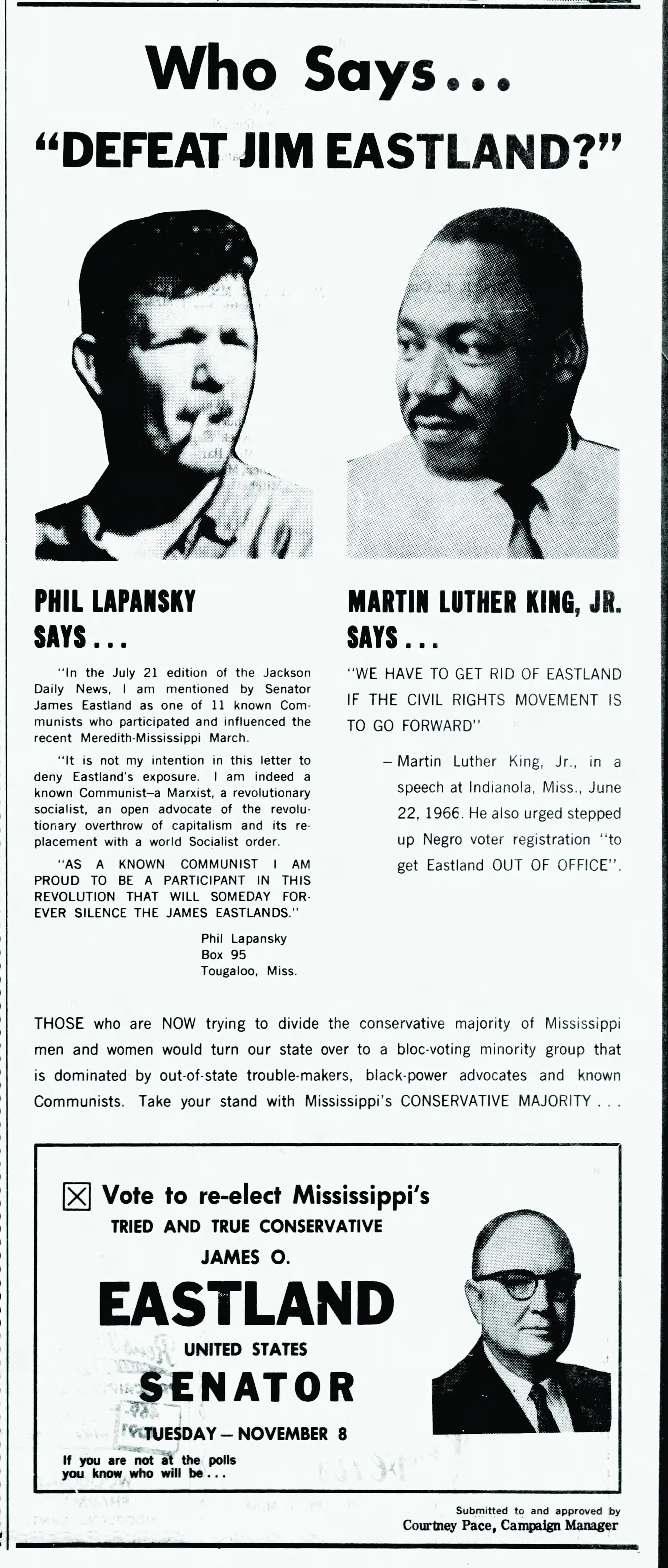
Eastland’s campaign would later use King’s words in Indianola in a fall statewide newspaper ad.
“Who says ‘defeat Jim Eastland?’” the ad read, with photos below of admitted communist Phil Lapansky and King. Below King’s photo, the Indianola quote, “We have to get rid of Jim Eastland if the Civil Rights movement is to go forward.”
Still shaken from the Philadelphia debacle, King became convinced in Indianola that the Meredith March should divert to Meridian and then to Philadelphia, according to newspaper reports.
National Director of the Congress for Racial Equality Floyd B. McKissick said in Indianola that a large segment of the march should have been diverted back to Neshoba County that week, according to the June 22, 1966 New York Times.
King agreed to that.
“We will use all our nonviolent might,” King was quoted as saying. He then lashed out again at Philadelphia.
“We got to go back – it’s the meanest town in the country,” The Times reported as King saying during a strategy session with other civil rights leaders in Indianola. “If they get by with what they did today, Negroes will be scared to death.”
McKissick agreed, according to The Times, saying, “We can’t take this lying down.”
The Times reported that McKissick suggested that the Meredith marchers be divided into two parts, “One going by truck to Meridian for a 41-mile march from there into Philadelphia along Route 19. The remaining marching column would continue on its way to Jackson by way of Canton.”
“Sounds good,” King said in The Times.
Like other press who had been present in Indianola on June 21, The Times reported zero violent incidents. The paper reported that about 350 Black people showed up for the rally, along with over 100 white people. The Times reported that many Blacks in the crowd started to chant “Black Power.”
“But when the Rev. Ralph Abernathy, one of Dr. King’s top aides arrived at the rally, he also asked Negroes what they wanted,” The Times said. “When some yelled ‘black power,’ he commanded, ‘Say freedom.’”
“Freedom,” the negroes shouted, according to The Times. When the rally ended, the crowd dispersed.
“Police officials in this deep-Delta city said today that Negro leader Martin Luther King had left for Yazoo City without a single reported incident of violence,” the DD-T reported on June 22.
Although a large group of King supporters gathered at Saint Benedict the Moor later that evening to hear King, he had already left town, arriving in Yazoo City, and by that time, ready to once again engage in fierce debate against the Black Power slogan.
King rededicated himself there to nonviolence and publicly denounced the new Black Power movement.
“Violence may bring about a temporary victory, but it can never bring about permanent peace,” King said in Yazoo, according to one newspaper report. “If we don’t use black power right, we will have black men with power who are just as evil as whites.”
While the nation’s press reported in detail the contents of King’s speech in Indianola, this newspaper had little to say about it, other than a front-page editor’s note by then-editor Wallace Dabbs.
Dabbs at first was snarky, making what seems to have been a deliberate attempt to not mention King’s name in the article.
“The march brought out one important fact which all serious-minded people (in) this area should be aware of,” Dabbs wrote. “The fact is this: A person can walk to Sunflower faster than a letter can be mailed from Indianola to Sunflower. And it is also a fact that by walking the walker will arrive some 24 or so more hours sooner than the letter. This, of course, is not a slam at the Indianola postal employees. It’s just that mail mailed in Indianola has to go around the Delta twice before it heads north on 49. Ah – progress our most important product – zip code and all.”
After the flip comment, Dabbs went on to praise the whites in Indianola for not being violent during the march.
“Seriously, the people of Indianola and Sunflower County can be proud of the way they conducted themselves during the trying Tuesday,” the editor said. “(Through) efforts of local leaders and able law officers, a much undesired element of people were allowed to come in and put on a dubious show. It could have been the other way around. It could have easily turned into an incident of which the flavor could have lingered here for days and weeks to come. But it didn’t happen that way. And two bodies of officers, the Sunflower County Sheriff’s Department under the direction of Sheriff Bill Hollowell, and the Indianola Police department, under the direction of Police Chief Bryce Alexander, deserve a round of applause.”
There are few other accounts of King’s speech in Indianola.
The rally drew about half the crowd as the one in Philadelphia. First-hand stories are limited. The splintered nature of the Meredith March that day had divided the press corps between Philadelphia and Yazoo City.
Most of what is known about the content of the speech comes from the Clarion Ledger, The Delta Democrat-Times, The New York Times and the wire news service reporters who were present.
No known photographs, television film or audio exist of King during his visit to Indianola. The speech is rarely spoken of in Civil Rights documentaries, perhaps overshadowed by the larger story in Neshoba County that day.
On a day when one of the world’s most revered peacemakers was fighting wars on multiple fronts, one against the Klan in Philadelphia, and another against the Black Power movement in his own organization, Martin Luther King Jr. needed a quiet place to vent, calm down and regroup for the next battle.
That venue was a humble pile of dirt in downtown Indianola.
This article first appeared on Mississippi Today and is republished here under a Creative Commons license.
Did you miss our previous article…
https://www.biloxinewsevents.com/?p=370729
Mississippi Today
Mississippi prepares for another execution
The Mississippi Supreme Court has set the execution of a man who kidnapped and murdered a 20-year-old community college student in north Mississippi 30 years ago.
Charles Ray Crawford, 59, is set to be executed Oct. 15 at the Mississippi State Penitentiary at Parchman, after multiple requests by the attorney general’s office.
Eight justices joined the majority opinion to set the execution, concluding that Crawford has exhausted all state and federal legal remedies. Mississippi Supreme Court Justice T. Kenneth Griffis Jr. wrote the Friday opinion. Justice David Sullivan did not participate.
However, Kristy Noble with the Mississippi Office of Capital Post-Conviction Counsel released a statement saying it will file another appeal with the U.S. Supreme Court.
“”Mr. Crawford’s inexperienced trial counsel conceded his guilt to the jury — against Mr.
Crawford’s timely and repeated objections,” Noble said in the statement. “Mr. Crawford told his counsel to pursue a not guilty verdict. Counsel did just the opposite, which is precisely what the U.S. Supreme Court says counsel cannot do,” Noble said in the statement.
“A trial like Mr. Crawford’s – one where counsel concedes guilt over his client’s express wishes – is essentially no trial at all.”
Last fall, Crawford’s attorneys asked the court not to set an execution date because he hadn’t exhausted appeal efforts in federal court to challenge a rape conviction that is not tied to his death sentence. In June, the U.S. Supreme Court declined to take up Crawford’s case.
A similar delay occurred a decade ago, when the AG’s office asked the court to reset Crawford’s execution date, but that was denied because efforts to appeal his unrelated rape conviction were still pending.
After each unsuccessful filing, the attorney general’s office asked the Mississippi Supreme Court to set Crawford’s execution date.
On Friday, the court also denied Crawford’s third petition for post-conviction relief and a request for oral argument. It accepted the state’s motion to dismiss the petition. Seven justices concurred and Justice Leslie King concurred in result only. Again, Justice Sullivan did not participate.
Crawford was convicted and sentenced to death in Lafayette County for the 1993 rape and murder of North Mississippi Community College student Kristy Ray.
Days before he was set to go to trial on separate aggravated assault and rape charges, he kidnapped Ray from her parents’ Tippah County home, leaving ransom notes. Crawford took Ray to an abandoned barn where he stabbed her, and his DNA was found on her, indicating he sexually assaulted her, according to court records.
Crawford told police he had blackouts and only remembered parts of the crime, but not killing Ray. Later he admitted “he must of killed her” and led police to Ray’s body, according to court records.
At his 1994 trial he presented an insanity defense, including that he suffered from psychogenic amnesia – periods of time lapse without memory. Medical experts who provided rebuttal testimony said Crawford didn’t have psychogenic amnesia and didn’t show evidence of bipolar illness.
The last person executed in Mississippi was Richard Jordan in June, previously the state’s oldest and longest serving person on death row.
There are 36 people on death row, according to records from the Mississippi Department of Corrections.
Update 9/15/25: This story has been updated to include a response from the Mississippi Office of Capital Post-Conviction Counsel
This article first appeared on Mississippi Today and is republished here under a Creative Commons Attribution-NoDerivatives 4.0 International License.
The post Mississippi prepares for another execution appeared first on mississippitoday.org
Note: The following A.I. based commentary is not part of the original article, reproduced above, but is offered in the hopes that it will promote greater media literacy and critical thinking, by making any potential bias more visible to the reader –Staff Editor.
Political Bias Rating: Centrist
The article presents a factual and balanced account of the legal proceedings surrounding a scheduled execution in Mississippi. It includes perspectives from both the state’s attorney general’s office and the defense counsel, without using emotionally charged language or advocating for a particular political stance. The focus on legal details and court decisions reflects a neutral, informative approach typical of centrist reporting.
Mississippi Today
Presidents are taking longer to declare major natural disasters. For some, the wait is agonizing
TYLERTOWN — As an ominous storm approached Buddy Anthony’s one-story brick home, he took shelter in his new Ford F-250 pickup parked under a nearby carport.
Seconds later, a tornado tore apart Anthony’s home and damaged the truck while lifting it partly in the air. Anthony emerged unhurt. But he had to replace his vehicle with a used truck that became his home while waiting for President Donald Trump to issue a major disaster declaration so that federal money would be freed for individuals reeling from loss. That took weeks.
“You wake up in the truck and look out the windshield and see nothing. That’s hard. That’s hard to swallow,” Anthony said.
Disaster survivors are having to wait longer to get aid from the federal government, according to a new Associated Press analysis of decades of data. On average, it took less than two weeks for a governor’s request for a presidential disaster declaration to be granted in the 1990s and early 2000s. That rose to about three weeks during the past decade under presidents from both major parties. It’s taking more than a month, on average, during Trump’s current term, the AP found.
The delays mean individuals must wait to receive federal aid for daily living expenses, temporary lodging and home repairs. Delays in disaster declarations also can hamper recovery efforts by local officials uncertain whether they will receive federal reimbursement for cleaning up debris and rebuilding infrastructure. The AP collaborated with Mississippi Today and Mississippi Free Press on the effects of these delays for this report.
“The message that I get in the delay, particularly for the individual assistance, is that the federal government has turned its back on its own people,” said Bob Griffin, dean of the College of Emergency Preparedness, Homeland Security and Cybersecurity at the University at Albany in New York. “It’s a fundamental shift in the position of this country.”
The wait for disaster aid has grown as Trump remakes government
The Federal Emergency Management Agency often consults immediately with communities to coordinate their initial disaster response. But direct payments to individuals, nonprofits and local governments must wait for a major disaster declaration from the president, who first must receive a request from a state, territory or tribe. Major disaster declarations are intended only for the most damaging events that are beyond the resources of states and local governments.
Trump has approved more than two dozen major disaster declarations since taking office in January, with an average wait of almost 34 days after a request. That ranged from a one-day turnaround after July’s deadly flash flooding in Texas to a 67-day wait after a request for aid because of a Michigan ice storm. The average wait is up from a 24-day delay during his first term and is nearly four times as long as the average for former Republican President George H.W. Bush, whose term from 1989-1993 coincided with the implementation of a new federal law setting parameters for disaster determinations.
The delays have grown over time, regardless of the party in power. Former Democratic President Joe Biden, in his last year in office, averaged 26 days to declare major disasters — longer than any year under former Democratic President Barack Obama.

FEMA did not respond to the AP’s questions about what factors are contributing to the trend.
Others familiar with FEMA noted that its process for assessing and documenting natural disasters has become more complex over time. Disasters have also become more frequent and intense because of climate change, which is mostly caused by the burning of fuels such as gas, coal and oil.
The wait for disaster declarations has spiked as Trump’s administration undertakes an ambitious makeover of the federal government that has shed thousands of workers and reexamined the role of FEMA. A recently published letter from current and former FEMA employees warned the cuts could become debilitating if faced with a large-enough disaster. The letter also lamented that the Trump administration has stopped maintaining or removed long-term planning tools focused on extreme weather and disasters.
Shortly after taking office, Trump floated the idea of “getting rid” of FEMA, asserting: “It’s very bureaucratic, and it’s very slow.”
FEMA’s acting chief suggested more recently that states should shoulder more responsibility for disaster recovery, though FEMA thus far has continued to cover three-fourths of the costs of public assistance to local governments, as required under federal law. FEMA pays the full cost of its individual assistance.
Former FEMA Administrator Pete Gaynor, who served during Trump’s first term, said the delay in issuing major disaster declarations likely is related to a renewed focus on making sure the federal government isn’t paying for things state and local governments could handle.
“I think they’re probably giving those requests more scrutiny,” Gaynor said. “And I think it’s probably the right thing to do, because I think the (disaster) declaration process has become the ‘easy button’ for states.”
The Associated Press on Monday received a statement from White House spokeswoman Abigail Jackson in response to a question about why it is taking longer to issue major natural disaster declarations:
“President Trump provides a more thorough review of disaster declaration requests than any Administration has before him. Gone are the days of rubber stamping FEMA recommendations – that’s not a bug, that’s a feature. Under prior Administrations, FEMA’s outsized role created a bloated bureaucracy that disincentivized state investment in their own resilience. President Trump is committed to right-sizing the Federal government while empowering state and local governments by enabling them to better understand, plan for, and ultimately address the needs of their citizens. The Trump Administration has expeditiously provided assistance to disasters while ensuring taxpayer dollars are spent wisely to supplement state actions, not replace them.”
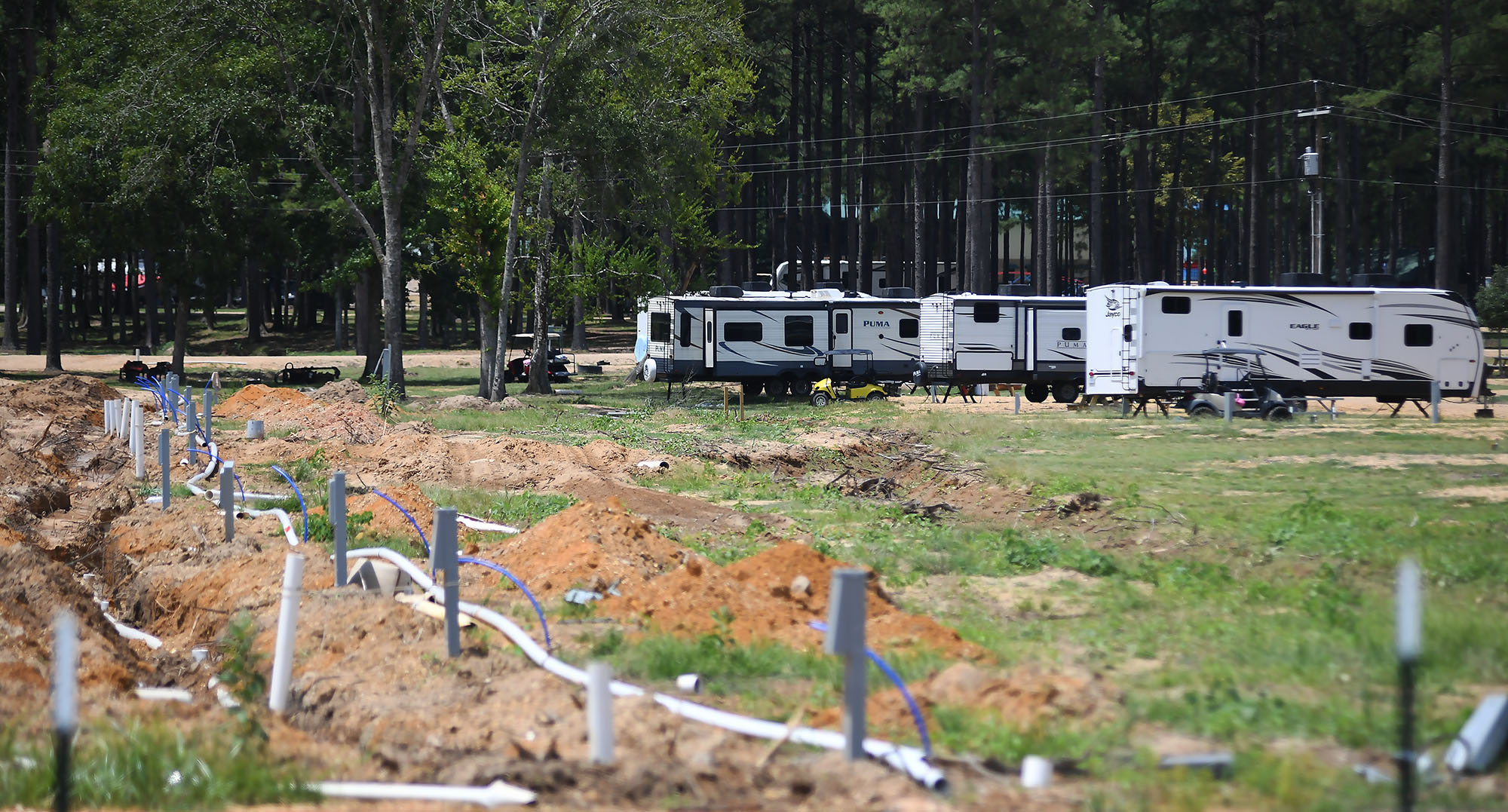
In Mississippi, frustration festered during wait for aid
The tornado that struck Anthony’s home in rural Tylertown on March 15 packed winds up to 140 mph. It was part of a powerful system that wrecked homes, businesses and lives across multiple states.
Mississippi’s governor requested a federal disaster declaration on April 1. Trump granted that request 50 days later, on May 21, while approving aid for both individuals and public entities.
On that same day, Trump also approved eight other major disaster declarations for storms, floods or fires in seven other states. In most cases, more than a month had passed since the request and about two months since the date of those disasters.
If a presidential declaration and federal money had come sooner, Anthony said he wouldn’t have needed to spend weeks sleeping in a truck before he could afford to rent the trailer where he is now living. His house was uninsured, Anthony said, and FEMA eventually gave him $30,000.
In nearby Jayess in Lawrence County, Dana Grimes had insurance but not enough to cover the full value of her damaged home. After the eventual federal declaration, Grimes said FEMA provided about $750 for emergency expenses, but she is now waiting for the agency to determine whether she can receive more.

“We couldn’t figure out why the president took so long to help people in this country,” Grimes said. “I just want to tie up strings and move on. But FEMA — I’m still fooling with FEMA.”
Jonathan Young said he gave up on applying for FEMA aid after the Tylertown tornado killed his 7-year-old son and destroyed their home. The process seemed too difficult, and federal officials wanted paperwork he didn’t have, Young said. He made ends meet by working for those cleaning up from the storm.
“It’s a therapy for me,” Young said, “to pick up the debris that took my son away from me.”
Historically, presidential disaster declarations containing individual assistance have been approved more quickly than those providing assistance only to public entities, according to the AP’s analysis. That remains the case under Trump, though declarations for both types are taking longer.
About half the major disaster declarations approved by Trump this year have included individual assistance.
Some people whose homes are damaged turn to shelters hosted by churches or local nonprofit organizations in the initial chaotic days after a disaster. Others stay with friends or family or go to a hotel, if they can afford it.
But some insist on staying in damaged homes, even if they are unsafe, said Chris Smith, who administered FEMA’s individual assistance division under three presidents from 2015-2022. If homes aren’t repaired properly, mold can grow, compounding the recovery challenges.
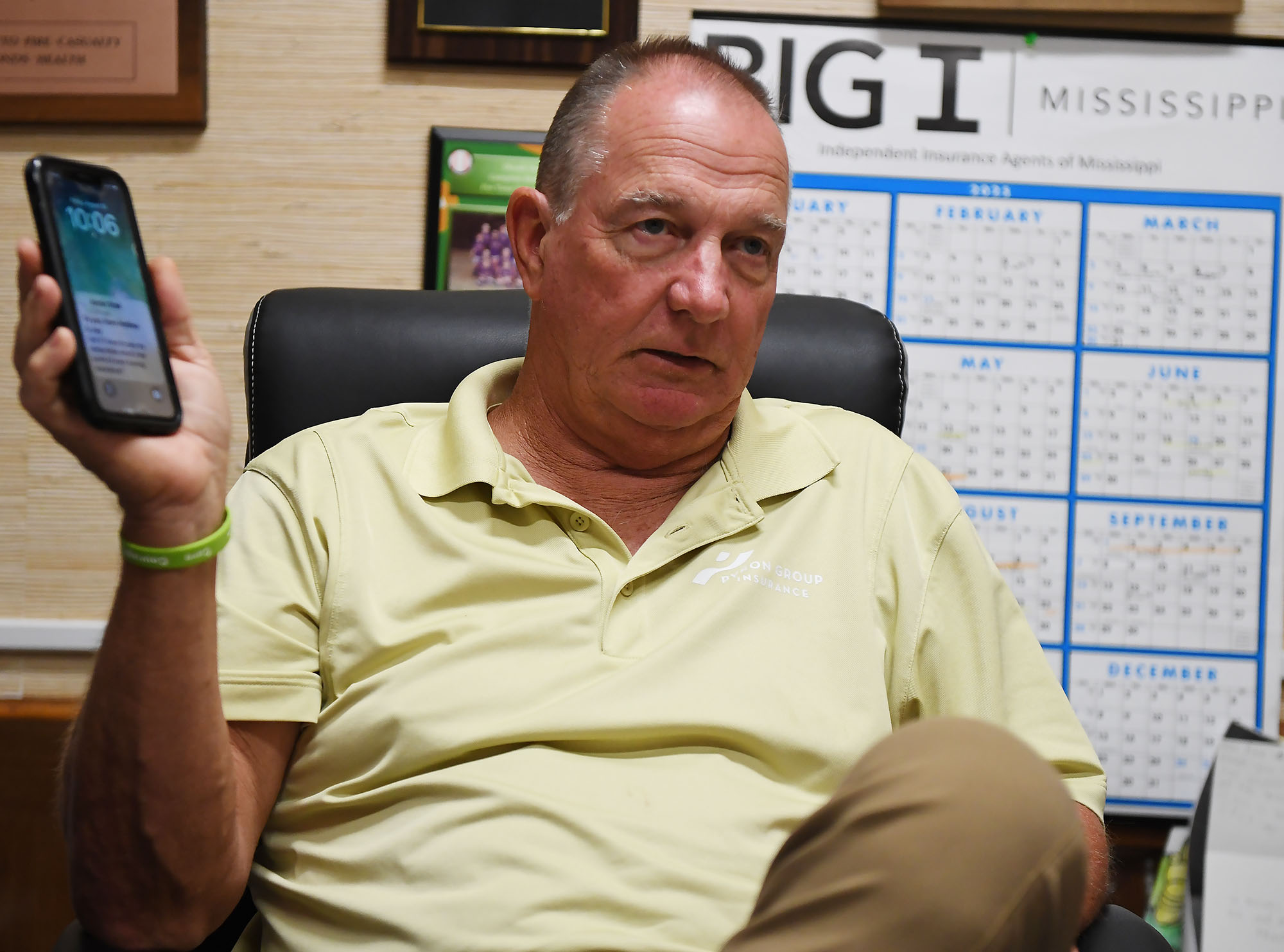
That’s why it’s critical for FEMA’s individual assistance to get approved quickly — ideally, within two weeks of a disaster, said Smith, who’s now a disaster consultant for governments and companies.
“You want to keep the people where they are living. You want to ensure those communities are going to continue to be viable and recover,” Smith said. “And the earlier that individual assistance can be delivered … the earlier recovery can start.”
In the periods waiting for declarations, the pressure falls on local officials and volunteers to care for victims and distribute supplies.
In Walthall County, where Tylertown is, insurance agent Les Lampton remembered watching the weather news as the first tornado missed his house by just an eighth of a mile. Lampton, who moonlights as a volunteer firefighter, navigated the collapsed trees in his yard and jumped into action. About 45 minutes later, the second tornado hit just a mile away.
“It was just chaos from there on out,” Lampton said.
Walthall County, with a population of about 14,000, hasn’t had a working tornado siren in about 30 years, Lampton said. He added there isn’t a public safe room in the area, although a lot of residents have ones in their home.
Rural areas with limited resources are hit hard by delays in receiving funds through FEMA’s public assistance program, which, unlike individual assistance, only reimburses local entities after their bills are paid. Long waits can stoke uncertainty and lead cost-conscious local officials to pause or scale-back their recovery efforts.
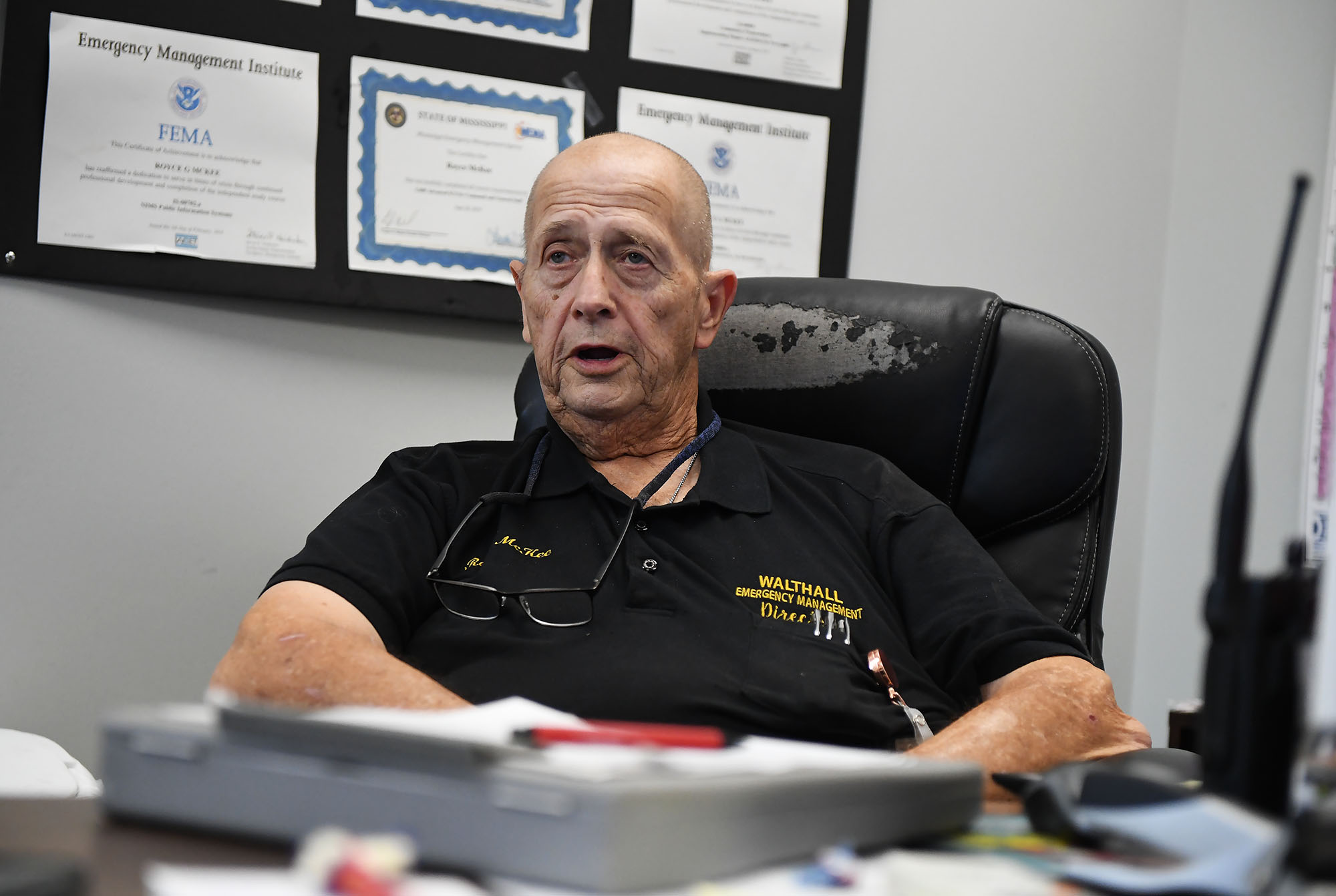
In Walthall County, officials initially spent about $700,000 cleaning up debris, then suspended the cleanup for more than a month because they couldn’t afford to spend more without assurance they would receive federal reimbursement, said county emergency manager Royce McKee. Meanwhile, rubble from splintered trees and shattered homes remained piled along the roadside, creating unsafe obstacles for motorists and habitat for snakes and rodents.
When it received the federal declaration, Walthall County took out a multimillion-dollar loan to pay contractors to resume the cleanup.
“We’re going to pay interest and pay that money back until FEMA pays us,” said Byran Martin, an elected county supervisor. “We’re hopeful that we’ll get some money by the first of the year, but people are telling us that it could be [longer].”
Lampton, who took after his father when he joined the volunteer firefighters 40 years ago, lauded the support of outside groups such as Cajun Navy, Eight Days of Hope, Samaritan’s Purse and others. That’s not to mention the neighbors who brought their own skid steers and power saws to help clear trees and other debris, he added.
“That’s the only thing that got us through this storm, neighbors helping neighbors,” Lampton said. “If we waited on the government, we were going to be in bad shape.”
Lieb reported from Jefferson City, Missouri, and Wildeman from Hartford, Connecticut.
Update 98/25: This story has been updated to include a White House statement released after publication.
This article first appeared on Mississippi Today and is republished here under a Creative Commons Attribution-NoDerivatives 4.0 International License.
The post Presidents are taking longer to declare major natural disasters. For some, the wait is agonizing appeared first on mississippitoday.org
Note: The following A.I. based commentary is not part of the original article, reproduced above, but is offered in the hopes that it will promote greater media literacy and critical thinking, by making any potential bias more visible to the reader –Staff Editor.
Political Bias Rating: Center-Left
This article presents a critical view of the Trump administration’s handling of disaster declarations, highlighting delays and their negative impacts on affected individuals and communities. It emphasizes concerns about government downsizing and reduced federal support, themes often associated with center-left perspectives that favor robust government intervention and social safety nets. However, it also includes statements from Trump administration officials defending their approach, providing some balance. Overall, the tone and framing lean slightly left of center without being overtly partisan.
Mississippi Today
Northeast Mississippi speaker and worm farmer played key role in Coast recovery after Hurricane Katrina
The 20th anniversary of Hurricane Katrina slamming the Mississippi Gulf Coast has come and gone, rightfully garnering considerable media attention.
But still undercovered in the 20th anniversary saga of the storm that made landfall on Aug. 29, 2005, and caused unprecedented destruction is the role that a worm farmer from northeast Mississippi played in helping to revitalize the Coast.
House Speaker Billy McCoy, who died in 2019, was a worm farmer from the Prentiss, not Alcorn County, side of Rienzi — about as far away from the Gulf Coast as one could be in Mississippi.
McCoy grew other crops, but a staple of his operations was worm farming.
Early after the storm, the House speaker made a point of touring the Coast and visiting as many of the House members who lived on the Coast as he could to check on them.
But it was his action in the forum he loved the most — the Mississippi House — that is credited with being key to the Coast’s recovery.
Gov. Haley Barbour had called a special session about a month after the storm to take up multiple issues related to Katrina and the Gulf Coast’s survival and revitalization. The issue that received the most attention was Barbour’s proposal to remove the requirement that the casinos on the Coast be floating in the Mississippi Sound.
Katrina wreaked havoc on the floating casinos, and many operators said they would not rebuild if their casinos had to be in the Gulf waters. That was a crucial issue since the casinos were a major economic engine on the Coast, employing an estimated 30,000 in direct and indirect jobs.
It is difficult to fathom now the controversy surrounding Barbour’s proposal to allow the casinos to locate on land next to the water. Mississippi’s casino industry that was birthed with the early 1990s legislation was still new and controversial.
Various religious groups and others had continued to fight and oppose the casino industry and had made opposition to the expansion of gambling a priority.
Opposition to casinos and expansion of casinos was believed to be especially strong in rural areas, like those found in McCoy’s beloved northeast Mississippi. It was many of those rural areas that were the homes to rural white Democrats — now all but extinct in the Legislature but at the time still a force in the House.
So, voting in favor of casino expansion had the potential of being costly for what was McCoy’s base of power: the rural white Democrats.
Couple that with the fact that the Democratic-controlled House had been at odds with the Republican Barbour on multiple issues ranging from education funding to health care since Barbour was inaugurated in January 2004.
Barbour set records for the number of special sessions called by the governor. Those special sessions often were called to try to force the Democratic-controlled House to pass legislation it killed during the regular session.
The September 2005 special session was Barbour’s fifth of the year. For context, current Gov. Tate Reeves has called four in his nearly six years as governor.
There was little reason to expect McCoy to do Barbour’s bidding and lead the effort in the Legislature to pass his most controversial proposal: expanding casino gambling.
But when Barbour ally Lt. Gov. Amy Tuck, who presided over the Senate, refused to take up the controversial bill, Barbour was forced to turn to McCoy.
The former governor wrote about the circumstances in an essay he penned on the 20th anniversary of Hurricane Katrina for Mississippi Today Ideas.
“The Senate leadership, all Republicans, did not want to go first in passing the onshore casino law,” Barbour wrote. “So, I had to ask Speaker McCoy to allow it to come to the House floor and pass. He realized he should put the Coast and the state’s interests first. He did so, and the bill passed 61-53, with McCoy voting no.
“I will always admire Speaker McCoy, often my nemesis, for his integrity in putting the state first.”
Incidentally, former Rep. Bill Miles of Fulton, also in northeast Mississippi, was tasked by McCoy with counting, not whipping votes, to see if there was enough support in the House to pass the proposal. Not soon before the key vote, Miles said years later, he went to McCoy and told him there were more than enough votes to pass the legislation so he was voting no and broached the idea of the speaker also voting no.
It is likely that McCoy would have voted for the bill if his vote was needed.
Despite his no vote, the Biloxi Sun Herald newspaper ran a large photo of McCoy and hailed the Rienzi worm farmer as a hero for the Mississippi Gulf Coast.
This article first appeared on Mississippi Today and is republished here under a Creative Commons Attribution-NoDerivatives 4.0 International License.
The post Northeast Mississippi speaker and worm farmer played key role in Coast recovery after Hurricane Katrina appeared first on mississippitoday.org
Note: The following A.I. based commentary is not part of the original article, reproduced above, but is offered in the hopes that it will promote greater media literacy and critical thinking, by making any potential bias more visible to the reader –Staff Editor.
Political Bias Rating: Centrist
The article presents a factual and balanced account of the political dynamics surrounding Hurricane Katrina recovery efforts in Mississippi, focusing on bipartisan cooperation between Democratic and Republican leaders. It highlights the complexities of legislative decisions without overtly favoring one party or ideology, reflecting a neutral and informative tone typical of centrist reporting.
-
News from the South - North Carolina News Feed6 days ago
What we know about Charlie Kirk shooting suspect, how he was caught
-
Local News7 days ago
Russian drone incursion in Poland prompts NATO leaders to take stock of bigger threats
-
Local News Video7 days ago
Introducing our WXXV Student Athlete of the Week, St. Patrick’s Parker Talley!
-
News from the South - North Carolina News Feed6 days ago
Federal hate crime charge sought in Charlotte stabbing | North Carolina
-
The Center Square7 days ago
Weapon recovered as manhunt continues in Kirk assassination investigation | National
-
News from the South - Alabama News Feed7 days ago
News 5 NOW at 8:00am | September 11, 2025
-
News from the South - Arkansas News Feed5 days ago
NW Arkansas Championship expected to bring money to Rogers
-
Our Mississippi Home4 days ago
Screech Owls – Small but Cute

